
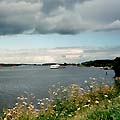
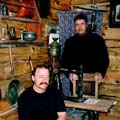
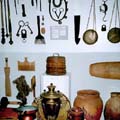
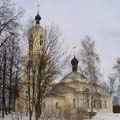
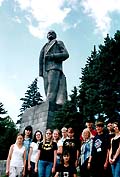
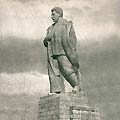
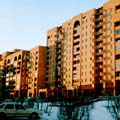
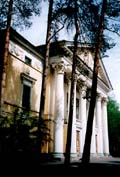
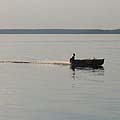
DUBNA.
Dubna is one of the most mysterious towns of the upper Volga. Its name has come down to us from ancient times. It is mentioned first in the Russian chronicles of 1134 in connection with the war between Novgorod and Suzdal: "Vsevolod went out with his army to set up his brother as the Suzdal governor, and then returned to Dubna". Later his name appears in a report of the feudal war of 1216 and then in 1451, when the Moscow prince Vasily Tyomny retreated to the Volga to muster troops during the last raid of the Tatars in Moscow. The Muscovites sustained the attacks and Tatars fell back.
The exhibits of the town museum, which were carefully collected by Yevgeny Krymov, give detailed information on the town and its neighborhood from the first appearance of inhabitants here up to the present.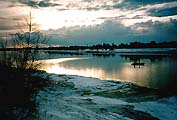 The instruments of labor of the primitive people, fractions of vessels and artifacts of the age of the scribe settlements of the prince, adornments and everyday articles of live made by ancient Russian craftsmen, crosses worn at the time of independent local principalities and the age of the centralized Russian state - are all articles that have been found on the eroded banks of the Volga at the former sites and settlements.
The instruments of labor of the primitive people, fractions of vessels and artifacts of the age of the scribe settlements of the prince, adornments and everyday articles of live made by ancient Russian craftsmen, crosses worn at the time of independent local principalities and the age of the centralized Russian state - are all articles that have been found on the eroded banks of the Volga at the former sites and settlements.
A.N. Radishchev, a Russian writer, traveled through this area during his famous trip from Petersburg to Moscow, V.N. Tatishchev, the first Russian historian had his estate here. At the Ratminskaya Strelka peninsula, which is formed by two rivers, the Volga and the Dubna, Prince A. Vyazemsky, Tatishchev's great-great grandson, built the Church of Praise to Our Lady. A few years ago this church became active again.
Before the October Revolution of 1917, what archaeologists call "The site of the ancient settlement at the mouth of the Dubna" and 11 neighboring villages were included in the Fyodorovskaya volost of the Korchevskoy uyezd of the Tver province. After the revolution, the landowner's estate was turned into "Dubna" State farm. In other villages, small collective farms were established during the mass collectivization campaign of the 1930s. This quiet rural life was interrupted by the construction of the Moscow - Volga Canal, which was started in 1933. And that was the beginning of modern times for this locality.
The idea of building a canal between the Volga river and Moscow is rather old. The first mention of a canal which has survived in the archives dates back to 1674. During the reign Peter the First, the number of such projects increased. In the 19th century, soldiers of a number of regiments worked 25 years to built a canal between two rivers, but the hard labor resulted in almost nothing: the canal was fit for only small boats.
It took 4 years and 8 months to built what is called the Moscow Canal. It was built by 700 thousand prisoners of the Dmitlag system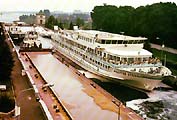 of labor prison camps. This figure was given by Varlam Shalamov, the writer, in his correspondence with Boris Pasternak. Among the builders of the canal there were peasants, office and factory workers, people of the arts. Here they underwent a "re-education program".
of labor prison camps. This figure was given by Varlam Shalamov, the writer, in his correspondence with Boris Pasternak. Among the builders of the canal there were peasants, office and factory workers, people of the arts. Here they underwent a "re-education program".
On the Volga a dam was constructed, and it created the Ivankovskaya reservoir with an area of 327 sq. km covering over the town of Korcheva and several villages. By 1937, the first hydropower station on the Volga, the Ivankovskaya, was built. Bolshaya Volga, a settlement of the river construction builders, came into being. In May, the first steamers went through the canal and thus Moscow became a port of five Seas.
Also in 1937, the construction of a hydroplane plant was started on the left bank of the Volga close to the dam. Now it is the Dubna Engineering Works.
The war left its imprint on this backwoods awoken by the industrialization. When the Nazi troops approached Moscow, the Ivankovskaya power station and the hydroplane plant were disassembled and evacuated, but they were returned to their original location already in 1942. Due to the heroic efforts of their workers, both works soon came up to full capacity.
In attempts to deprive Moscow of water, the enemy's aviation attacked the Ivankovskaya power station. The station and settle-battalion were defended by an anti-aircraft battalion, in memory of which a pillbox was reconstructed near the dam after the war. The nearness of the front line is also seen in the disposition at the school in Bolshaya Volga of the mobile surgical hospital No 101, where the wounded of the 30th Army were treated. That Army, headed by general Lelyushenko, fought on the Kalininsky front. The wounded who died here were buried in a communal grave, and later a memorial was constructed. Victory Day ceremonies are held every year here. To commemorate the hospital, a plaque was installed at school No 2.
Ten years after the completion of the Moscow Canal, a new construction was started near the place where it joined the Volga.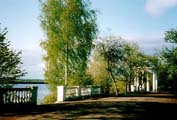
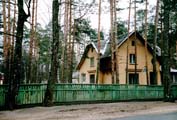
The geographical location and favourable natural conditions with its relative closeness to Moscow became the major reasons for locating a scientific center for nuclear research here.
It was begun with the construction of two laboratories, the hydrotechnical and electrophysical. One of the first to arrive here was M.G. Meshcheryakov, the first director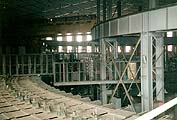 of the scientific center. He came here in the spring of 1947. Here is how he described what later developed into the town of Dubna: "All around was a solid wet forest without any openings. Workers made cutting in the forest for roads and hurried to rig up a wooden mooring before the ice of the Volga broke up. A group of land-surveyors laid out the streets of the future science town and the railway branch".
of the scientific center. He came here in the spring of 1947. Here is how he described what later developed into the town of Dubna: "All around was a solid wet forest without any openings. Workers made cutting in the forest for roads and hurried to rig up a wooden mooring before the ice of the Volga broke up. A group of land-surveyors laid out the streets of the future science town and the railway branch".
Already by the end of 1949, when the synchrocyclotron ( the first accelerator in Dubna) went into operation, the construction of dwelling houses along the Joliot-Curie, Sovetskaya and Parkovaya (now Veksler) streets, which formed the basis of the scientific town, were completed. Old residents if Dubna say that it was not a common practice to lock one's doors; life was hard but enthusiasm was high. At the beginning of 1956, 11 countries of the former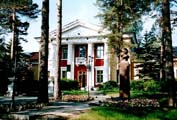 Socialist commonwealth established the Joint Institute for Nuclear Research (JINR) in Dubna. It became the first international scientific center in the Soviet Union. In July 1956, by edict of the Presidium of the Supreme Soviet if Russia Dubna ws given the status of a town, and due to JINR, it developed as an international center of research of the highest quality.
Socialist commonwealth established the Joint Institute for Nuclear Research (JINR) in Dubna. It became the first international scientific center in the Soviet Union. In July 1956, by edict of the Presidium of the Supreme Soviet if Russia Dubna ws given the status of a town, and due to JINR, it developed as an international center of research of the highest quality.
Such famous physicists as N.N. Bogoliubov, I.M. Frank, G.N. Flyorov, D.I. Blokhintsev, B.M. Pontecorvo and V.I. Veksler worked in Dubna. There are streets in Dubna named after them.
But Dubna is more then just science. On the banks of the Volga, several large plants have sprung up around the Institute, and they too concentrate on immense intellectual potential.
Dubna occupies a territory of 7166 hectares, its population is more then 68 thousand, and there are about 1.5 thousand large and small enterprises of different forms of property, 31 preschool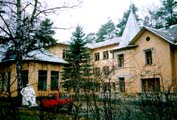 children's institutions, 11 state schools and 5 private schools, several art institutions. There are two colleges, the "Dubna University for Nature, Society and Man, branches of the Moscow Institute of Radio Engineering, Electronics and Automatics and the Institute of Nuclear Physics of Moscow State University, 2 TV studios, 5 newspapers, and a local radio station.
children's institutions, 11 state schools and 5 private schools, several art institutions. There are two colleges, the "Dubna University for Nature, Society and Man, branches of the Moscow Institute of Radio Engineering, Electronics and Automatics and the Institute of Nuclear Physics of Moscow State University, 2 TV studios, 5 newspapers, and a local radio station.
Dubna is widely known for its developed cultural traditions. There are regular festivals of classical music, celebrations of choir music (in Dubna there are more than ten choir groups and studios), competitions of violinists and contests of talented youth. Many creative groups of the city are unique and well known, not only in Russia, but also abroad.
Dubnavites are proud of the high achievements of their city athletes. The water ski school of the Nekhaevsky brothers is known through the world. It's enough to say that all the international records that are held by Russians in the sport of water skiing (and these include five world and nine European records) - all these were established by Dubna sportsmen. Also popular in the city are chess, weight lifting, tennis, sailing, biking, skiing and swimming. Altogether in the city more than twenty forms of sports are practiced.
The town is connected with Moscow by a railwayl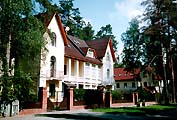 and federal highway. The railway communication is provided by suburban trains and more comfortable nonstop trains. There is also bus communication between Dubna and Moscow.
and federal highway. The railway communication is provided by suburban trains and more comfortable nonstop trains. There is also bus communication between Dubna and Moscow.
What makes Dubna so unique? Why does it stand out among all science towns of the country? The neighboring forests, Moscow, the Volga, Dubna and Sestra rivers offer much to fishmen and hunters and to collectors of mushrooms and berries, many of whom have their own favourite haunts and secret sites. The favoutite recreation place for most Dubnians is Ratminskaya Strelka peninsula, which is now a historical and landscape reserve.
Dubna continues to attract people from all parts of the world with its unique past, original present and extraordinary future. Everyone here has a particular feeling of well-being in his work, his creative activities and his rest.
You can find more information on the official website of Dubna http://www.dubna.ru .
Designed by Alex.
The exhibits of the town museum, which were carefully collected by Yevgeny Krymov, give detailed information on the town and its neighborhood from the first appearance of inhabitants here up to the present.
 The instruments of labor of the primitive people, fractions of vessels and artifacts of the age of the scribe settlements of the prince, adornments and everyday articles of live made by ancient Russian craftsmen, crosses worn at the time of independent local principalities and the age of the centralized Russian state - are all articles that have been found on the eroded banks of the Volga at the former sites and settlements.
The instruments of labor of the primitive people, fractions of vessels and artifacts of the age of the scribe settlements of the prince, adornments and everyday articles of live made by ancient Russian craftsmen, crosses worn at the time of independent local principalities and the age of the centralized Russian state - are all articles that have been found on the eroded banks of the Volga at the former sites and settlements.
A.N. Radishchev, a Russian writer, traveled through this area during his famous trip from Petersburg to Moscow, V.N. Tatishchev, the first Russian historian had his estate here. At the Ratminskaya Strelka peninsula, which is formed by two rivers, the Volga and the Dubna, Prince A. Vyazemsky, Tatishchev's great-great grandson, built the Church of Praise to Our Lady. A few years ago this church became active again.
Before the October Revolution of 1917, what archaeologists call "The site of the ancient settlement at the mouth of the Dubna" and 11 neighboring villages were included in the Fyodorovskaya volost of the Korchevskoy uyezd of the Tver province. After the revolution, the landowner's estate was turned into "Dubna" State farm. In other villages, small collective farms were established during the mass collectivization campaign of the 1930s. This quiet rural life was interrupted by the construction of the Moscow - Volga Canal, which was started in 1933. And that was the beginning of modern times for this locality.
The idea of building a canal between the Volga river and Moscow is rather old. The first mention of a canal which has survived in the archives dates back to 1674. During the reign Peter the First, the number of such projects increased. In the 19th century, soldiers of a number of regiments worked 25 years to built a canal between two rivers, but the hard labor resulted in almost nothing: the canal was fit for only small boats.
It took 4 years and 8 months to built what is called the Moscow Canal. It was built by 700 thousand prisoners of the Dmitlag system
 of labor prison camps. This figure was given by Varlam Shalamov, the writer, in his correspondence with Boris Pasternak. Among the builders of the canal there were peasants, office and factory workers, people of the arts. Here they underwent a "re-education program".
of labor prison camps. This figure was given by Varlam Shalamov, the writer, in his correspondence with Boris Pasternak. Among the builders of the canal there were peasants, office and factory workers, people of the arts. Here they underwent a "re-education program".
On the Volga a dam was constructed, and it created the Ivankovskaya reservoir with an area of 327 sq. km covering over the town of Korcheva and several villages. By 1937, the first hydropower station on the Volga, the Ivankovskaya, was built. Bolshaya Volga, a settlement of the river construction builders, came into being. In May, the first steamers went through the canal and thus Moscow became a port of five Seas.
Also in 1937, the construction of a hydroplane plant was started on the left bank of the Volga close to the dam. Now it is the Dubna Engineering Works.
The war left its imprint on this backwoods awoken by the industrialization. When the Nazi troops approached Moscow, the Ivankovskaya power station and the hydroplane plant were disassembled and evacuated, but they were returned to their original location already in 1942. Due to the heroic efforts of their workers, both works soon came up to full capacity.
In attempts to deprive Moscow of water, the enemy's aviation attacked the Ivankovskaya power station. The station and settle-battalion were defended by an anti-aircraft battalion, in memory of which a pillbox was reconstructed near the dam after the war. The nearness of the front line is also seen in the disposition at the school in Bolshaya Volga of the mobile surgical hospital No 101, where the wounded of the 30th Army were treated. That Army, headed by general Lelyushenko, fought on the Kalininsky front. The wounded who died here were buried in a communal grave, and later a memorial was constructed. Victory Day ceremonies are held every year here. To commemorate the hospital, a plaque was installed at school No 2.
Ten years after the completion of the Moscow Canal, a new construction was started near the place where it joined the Volga.


The geographical location and favourable natural conditions with its relative closeness to Moscow became the major reasons for locating a scientific center for nuclear research here.
It was begun with the construction of two laboratories, the hydrotechnical and electrophysical. One of the first to arrive here was M.G. Meshcheryakov, the first director
 of the scientific center. He came here in the spring of 1947. Here is how he described what later developed into the town of Dubna: "All around was a solid wet forest without any openings. Workers made cutting in the forest for roads and hurried to rig up a wooden mooring before the ice of the Volga broke up. A group of land-surveyors laid out the streets of the future science town and the railway branch".
of the scientific center. He came here in the spring of 1947. Here is how he described what later developed into the town of Dubna: "All around was a solid wet forest without any openings. Workers made cutting in the forest for roads and hurried to rig up a wooden mooring before the ice of the Volga broke up. A group of land-surveyors laid out the streets of the future science town and the railway branch".
Already by the end of 1949, when the synchrocyclotron ( the first accelerator in Dubna) went into operation, the construction of dwelling houses along the Joliot-Curie, Sovetskaya and Parkovaya (now Veksler) streets, which formed the basis of the scientific town, were completed. Old residents if Dubna say that it was not a common practice to lock one's doors; life was hard but enthusiasm was high. At the beginning of 1956, 11 countries of the former
 Socialist commonwealth established the Joint Institute for Nuclear Research (JINR) in Dubna. It became the first international scientific center in the Soviet Union. In July 1956, by edict of the Presidium of the Supreme Soviet if Russia Dubna ws given the status of a town, and due to JINR, it developed as an international center of research of the highest quality.
Socialist commonwealth established the Joint Institute for Nuclear Research (JINR) in Dubna. It became the first international scientific center in the Soviet Union. In July 1956, by edict of the Presidium of the Supreme Soviet if Russia Dubna ws given the status of a town, and due to JINR, it developed as an international center of research of the highest quality.
Such famous physicists as N.N. Bogoliubov, I.M. Frank, G.N. Flyorov, D.I. Blokhintsev, B.M. Pontecorvo and V.I. Veksler worked in Dubna. There are streets in Dubna named after them.
But Dubna is more then just science. On the banks of the Volga, several large plants have sprung up around the Institute, and they too concentrate on immense intellectual potential.
Dubna occupies a territory of 7166 hectares, its population is more then 68 thousand, and there are about 1.5 thousand large and small enterprises of different forms of property, 31 preschool
 children's institutions, 11 state schools and 5 private schools, several art institutions. There are two colleges, the "Dubna University for Nature, Society and Man, branches of the Moscow Institute of Radio Engineering, Electronics and Automatics and the Institute of Nuclear Physics of Moscow State University, 2 TV studios, 5 newspapers, and a local radio station.
children's institutions, 11 state schools and 5 private schools, several art institutions. There are two colleges, the "Dubna University for Nature, Society and Man, branches of the Moscow Institute of Radio Engineering, Electronics and Automatics and the Institute of Nuclear Physics of Moscow State University, 2 TV studios, 5 newspapers, and a local radio station.
Dubna is widely known for its developed cultural traditions. There are regular festivals of classical music, celebrations of choir music (in Dubna there are more than ten choir groups and studios), competitions of violinists and contests of talented youth. Many creative groups of the city are unique and well known, not only in Russia, but also abroad.
Dubnavites are proud of the high achievements of their city athletes. The water ski school of the Nekhaevsky brothers is known through the world. It's enough to say that all the international records that are held by Russians in the sport of water skiing (and these include five world and nine European records) - all these were established by Dubna sportsmen. Also popular in the city are chess, weight lifting, tennis, sailing, biking, skiing and swimming. Altogether in the city more than twenty forms of sports are practiced.
The town is connected with Moscow by a railwayl
 and federal highway. The railway communication is provided by suburban trains and more comfortable nonstop trains. There is also bus communication between Dubna and Moscow.
and federal highway. The railway communication is provided by suburban trains and more comfortable nonstop trains. There is also bus communication between Dubna and Moscow.
What makes Dubna so unique? Why does it stand out among all science towns of the country? The neighboring forests, Moscow, the Volga, Dubna and Sestra rivers offer much to fishmen and hunters and to collectors of mushrooms and berries, many of whom have their own favourite haunts and secret sites. The favoutite recreation place for most Dubnians is Ratminskaya Strelka peninsula, which is now a historical and landscape reserve.
Dubna continues to attract people from all parts of the world with its unique past, original present and extraordinary future. Everyone here has a particular feeling of well-being in his work, his creative activities and his rest.
You can find more information on the official website of Dubna http://www.dubna.ru .